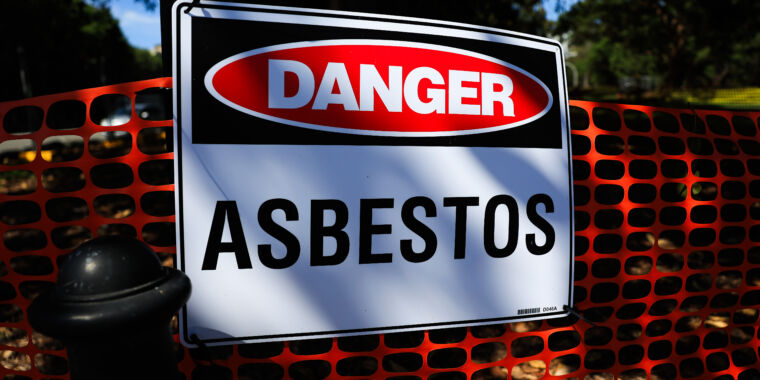Chrysotile asbestos finally banned in the US after decades of EPA efforts

Long time coming —
But, companies will have up to 12 years to phase out chrysotile asbestos.

Enlarge / An asbestos warning sign is seen at Victoria Park in Camperdown on February 29, 2024 in Sydney, Australia.
The Environmental Protection Agency on Monday finalized a ban on the only type of asbestos still used in the US, chrysotile asbestos. This move was decades in the making.
Chrysotile asbestos, aka “white asbestos,” is still imported, processed, and used in the US for diaphragms (including those used to make sodium hydroxide and chlorine), sheet gaskets, brake blocks, aftermarket automotive brakes/linings, other vehicle friction products, and other gaskets, the EPA notes.
Exposure to asbestos is known to cause lung cancer, mesothelioma, ovarian cancer, and laryngeal cancer. And asbestos is linked to more than 40,000 deaths annually just in the US.
“The science is clear—asbestos is a known carcinogen that has severe impacts on public health,” EPA Administrator Michael Regan said in a statement. “President Biden understands that this concern that has spanned generations and impacted the lives of countless people. That’s why EPA is so proud to finalize this long-needed ban on ongoing uses of asbestos.”
The US ban comes after decades of efforts, and the US now joins more than 50 other countries that have already passed bans. The EPA originally tried banning asbestos in 1989 under the George H. W. Bush administration. But a federal court struck down the ban in 1991 and weakened the EPA’s authority. In 2016, Congress passed amendments to strengthen the 1976 Toxic Substances Control Act, opening the door to renewing an EPA ban on the fibrous silicate mineral. But, under the Trump administration, the EPA failed to do so.
Trump has directly supported the use of asbestos, writing in his 1997 book The Art of the Comeback that it is “100% safe, once applied.” He blamed the mob for efforts to discontinue its use: “I believe that the movement against asbestos was led by the mob, because it was often mob-related companies that would do the asbestos removal.” In 2018, a Russian asbestos company began marketing the carcinogenic mineral with Trump’s image and a seal reading “Approved by Donald Trump, 45th President of the United States.” Russia has been a primary supplier of asbestos to the US.
Trump is once again running for president and could move to undo the ban if he wins in November. That is one of the reasons some are calling on Congress to pass a law to ban all types of asbestos outright, The New York Times reported. Senator Jeff Merkley (D-Ore.) said the EPA’s move today is “a long overdue step forward for public health. However, it cannot be the end of the road when it comes to phasing out other dangerous asbestos fibers, and Congress has a role to play here when it comes to providing stronger protections for our health.”
As it is, the EPA’s ban provides a lot of time for some companies to phase out the use of chrysotile asbestos. While the new EPA rule will immediately ban the import of asbestos for chlor-alkali sector, which uses asbestos diaphragms to disinfect drinking water and wastewater, the facilities actually using such diaphragms will have up to 12 years to transition to non-asbestos membranes. According to the EPA, there are eight facilities in the US that use these asbestos-containing diaphragms, six of which are expected to phase them out within five years. But the EPA gave more leeway to companies with multiple facilities, giving them up to five years to convert the first facility, up to eight years to convert the second, and up to 12 to convert the third.
Meanwhile, the ban will go into effect for most sheet gaskets that contain asbestos in two years, while sheet gaskets to be used to produce titanium dioxide and for the processing of nuclear material will have a five-year phase-out. Abestos-containing oilfield brake blocks, aftermarket automotive brakes and linings, other vehicle friction products, and other gaskets will see the ban take effect in six months.



